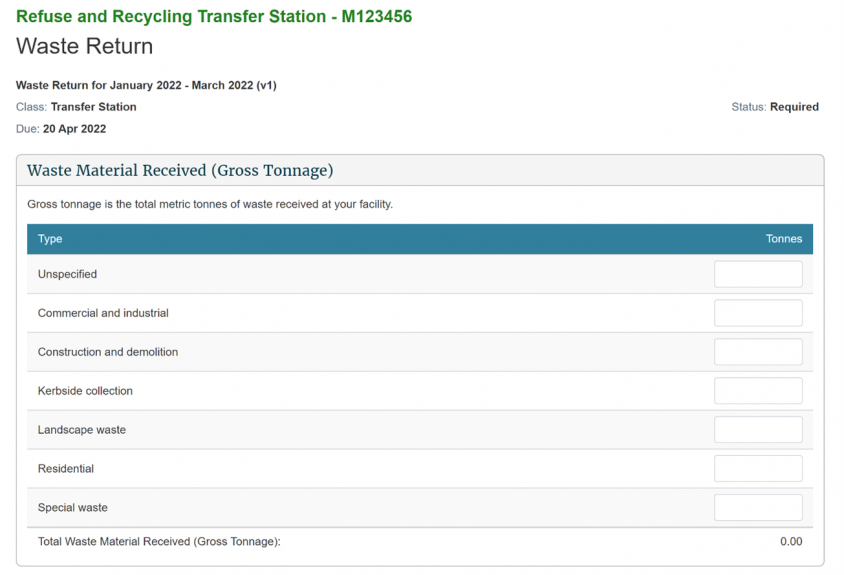Additional information for site operators: OWLS
Additional information to help site operators prepare returns in the Online Waste Levy System (OWLS).
Additional information to help site operators prepare returns in the Online Waste Levy System (OWLS).
When returns are prepared in the Online Waste Levy System (OWLS) operators input gross and diverted tonnages. Net tonnage is automatically calculated.
Gross tonnage = the total tonnage of waste and diverted material (eg, recyclables) that enters the facility.
Diverted tonnage = the tonnage of material that enters the facility as gross tonnage but is either reused or recycled or removed from the facility within six months.
The 6-month timeframe for diverted materials does not apply for transfer stations, industrial monofills, or cleanfills.
All diverted tonnage, even if it is stockpiled on site, must be measured.
For transfer stations diverted tonnage means material that is sent to be re-used or recycled.
Transfer station operators should also refer to the ‘Transfer station returns’ section of this page for further information on transfer station returns.
Net tonnage = the gross tonnage minus the diverted tonnage.
You can use:
Find more information in the factsheet Waste levy – Measuring waste tonnages
Tonnages of material that is re-used must be captured as gross tonnage (when it enters the facility) and diverted tonnage (when it is re-used).
The Waste Minimisation Act defines ‘reuse’ as being the further use of waste or diverted material in its existing form for the original purpose of the materials or for a similar purpose.
Find more information about reuse, including acceptable forms of reuse, in the factsheet - Waste levy – Reuse of waste materials on site.
Gross and diverted tonnages can be reported by material type.
Where possible, reporting by material type is preferred as it provides the Ministry with additional waste data.
Gross tonnages can be reported by the type of activity that generated the waste (eg, construction and demolition, kerbside collection). Diverted materials can be reported by material type (eg, glass, paper etc).
The screenshots from OWLs show the material type categories currently available. Operators are not currently required to use these categories unless they wish to do so. (To access the information from the screenshots in OWLs see the table on waste material received (gross tonnage) and the table on diverted materials.)
The Ministry acknowledges that the existing categories do not contain all applicable waste streams. The unspecified category should be used when there is no appropriate category for an existing waste stream.


From 1 July 2024, all waste facility operators are required to collect data and report on the source of the waste they receive — (activity category reporting).
Activity category data should be submitted into OWLS at the same time you submit your waste return. The OWLS system is currently being updated to reflect these new categories. More detailed information on how to submit this information will become available soon.
For more information see:
For further queries please contact:
When returns are submitted in OWLS operators sign a declaration.
The declaration wording is provided here for reference [PDF, 239 KB]
Regulation 10 of the Waste Minimisation (Information Requirements) Regulations 2021 describes what must be measured by operator of transfer station:
(a) in accordance with regulation 11, the tonnage of waste or diverted material that enters the facility (gross tonnage); and
(b) in accordance with regulation 12, the tonnage of waste or diverted material that is reused or recycled at the facility, or is removed from the facility (other than as described in paragraph (C)) (diverted tonnage); and
(C) the tonnage of waste (if any) that is sent from the facility to a disposal facility for disposal or elsewhere for further processing.
The gross tonnage (a), should include the tonnage of all material entering the facility (waste material and recycling).
The diverted tonnage (b), should include the tonnage of all recyclables diverted, but should not include the tonnage of waste material sent to landfill.
Net tonnage is automatically calculated in your return as derived from the gross tonnage figure minus the diverted tonnage figure (as shown in the screenshot below). Net tonnage covers part (C) of regulation 10, and reflects the tonnage of waste that is sent to landfill or elsewhere for further processing.
Facilities that collect less than 1000 net tonnes of waste per year can seek approval to submit annual returns. Net tonnage does not include diverted material as it is calculated as gross tonnage minus diverted tonnage.
An application for annual permissions must be submitted by 20 July of the financial year the application relates to. A decision will be made by 1 August of the same year. For instance, if you wish to submit an annual return for the 2022/23 financial year, your application would be due on 20 July 2022.
Operators are not required to record/report the tonnages of any material that comes to a transfer station for the sole purpose of using the weighbridge. For auditing purposes please ensure that this activity is clearly noted in any weighbridge records or product codes.
See also Additional information for transfer station operators